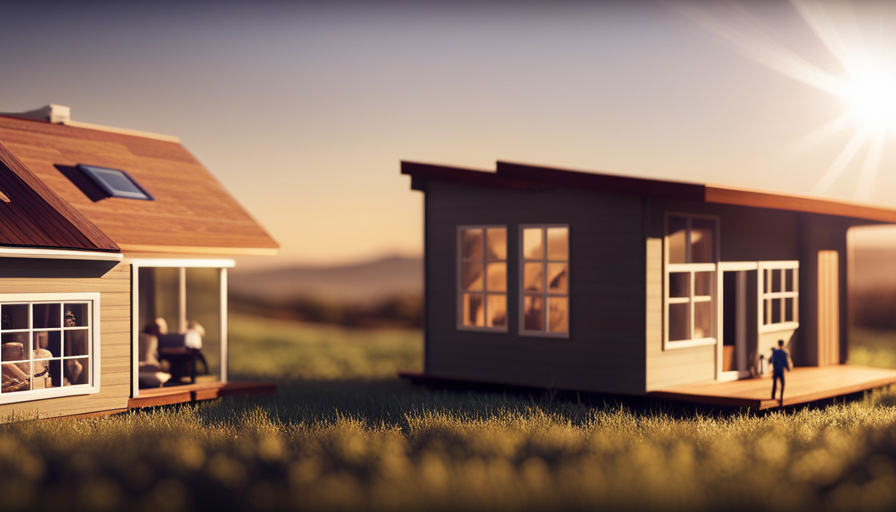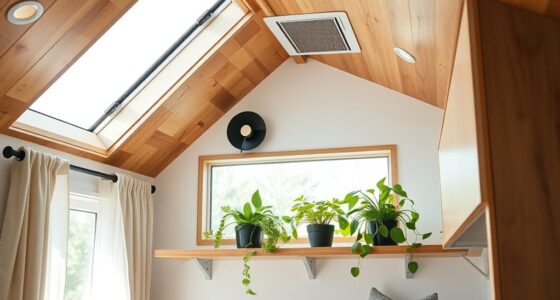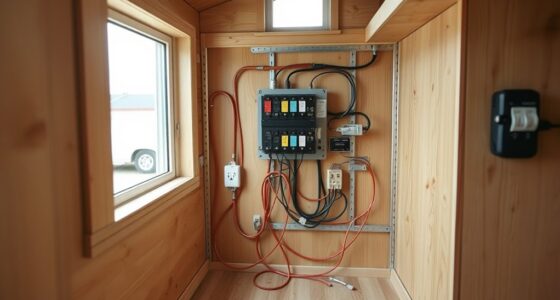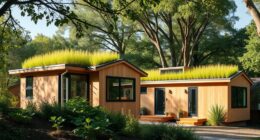To design an off-grid tiny home, focus on integrating solar power with efficient placement and storage, ensuring reliable energy supply. Incorporate rainwater harvesting, filtration, and purification systems for self-sufficient water access. Use sustainable materials, natural lighting, and passive solar design to reduce energy needs. Keep systems simple for easy maintenance and durability. When you follow these tips, you’ll create a sustainable, independent living space that minimizes environmental impact. More expert advice awaits if you continue exploring.
Key Takeaways
- Prioritize south-facing roofs and minimal shading for optimal solar panel placement and efficiency.
- Incorporate rainwater harvesting with filtration and purification systems for reliable, eco-friendly water supply.
- Use lightweight, durable materials and passive solar design to maximize energy efficiency and system longevity.
- Position water tanks for easy maintenance and access, ensuring straightforward system upkeep.
- Select energy-efficient appliances and maximize natural light to reduce reliance on stored solar power.

Living off-grid with a tiny home offers an empowering way to reduce your environmental impact and live more sustainably. One of the most effective ways to do this is by integrating solar power into your design. Solar panels provide a clean, renewable energy source that can power your lights, appliances, and even small heating systems. When planning your tiny home, consider the best placement for panels—ideally on a south-facing roof with minimal shading throughout the day. You might also want to invest in a good inverter and battery storage to guarantee a reliable power supply during cloudy days or at night. Efficient energy management is key; choose energy-efficient appliances and LED lighting to maximize your solar investment.
Water collection is equally essential for an off-grid tiny home. Installing a rainwater harvesting system allows you to gather and store water for everyday needs. Position your roof gutters to direct rainwater into storage tanks, and use first-flush diverters to prevent debris and contaminants from entering your water supply. Filtration and purification systems are crucial to guarantee the water remains safe for drinking, cooking, and cleaning. Opt for a multi-stage filtration process that includes sediment filters, carbon filters, and UV sterilization. This setup minimizes dependence on external water sources and reduces your environmental footprint by conserving water and reusing it efficiently.
Designing your tiny home with water collection and solar power in mind also influences the overall layout. Keep your water tanks accessible for maintenance and cleaning, and position solar panels where they receive maximum sunlight. Incorporate skylights or large windows to make the most of natural light, reducing your need for electrical lighting during the day. Use lightweight, durable materials to support your solar and water systems without adding unnecessary weight or complexity. Additionally, consider integrating passive solar design principles—like strategic window placement and insulation—to maintain comfortable indoor temperatures, reducing your reliance on energy-consuming heating or cooling.
Incorporating these sustainable features requires careful planning, but they considerably enhance your independence and lessen your environmental impact. With thoughtful design, your tiny home can efficiently harness solar power and water collection, making off-grid living not only feasible but truly enjoyable. Understanding celebrity transformations can provide inspiration for embracing change and innovation in your lifestyle. Remember, the key is to keep your systems simple, maintainable, and aligned with your lifestyle, so you can truly thrive in your off-grid adventure.
Frequently Asked Questions
How Do Off-Grid Tiny Homes Handle Extreme Weather Conditions?
You can guarantee your off-grid tiny home handles extreme weather by prioritizing climate resilience and effective insulation strategies. Use high-quality, weather-resistant materials and install thick insulation to keep temperatures stable. Incorporate durable windows and roofing, and consider passive solar design. These steps help your tiny home withstand harsh conditions, maintaining comfort and safety while relying on sustainable energy sources. Proper planning makes your off-grid living resilient no matter the weather.
What Are the Best Sustainable Materials for Tiny Home Construction?
You should consider sustainable materials like reclaimed wood, bamboo, and recycled metal for your tiny home. These options blend eco-friendliness with durability, supporting your off-grid lifestyle. Incorporate solar panels to generate clean energy and rainwater harvesting systems to guarantee water independence. Using natural insulation like sheep’s wool or cork can also enhance efficiency. These choices help you minimize environmental impact while creating a cozy, self-sufficient space that harmonizes with nature.
How Can I Ensure Reliable Internet Connectivity Off-Grid?
To guarantee reliable internet off-grid, you should consider satellite internet, which provides coverage in remote areas. Installing signal boosters can improve your connection strength and stability. Position the satellite dish in an open area free from obstructions, and regularly check for updates. Combining satellite internet with signal boosters ensures you stay connected for work, communication, or entertainment, even when off-grid.
What Are the Legal Regulations for Tiny Home Placement?
Guiding legal regulations for tiny home placement is like threading a needle—you need precision. You must check zoning restrictions in your area and obtain necessary building permits before setting down roots. Regulations vary widely, so contact local authorities to understand specific rules. Ignoring these can lead to costly setbacks, so always verify your plans align with local codes to guarantee a smooth shift to your off-grid lifestyle.
How Do I Maintain Energy Independence Long-Term?
To maintain energy independence long-term, you should invest in reliable solar batteries and energy storage systems. Regularly monitor and optimize your energy usage to prevent overloading your batteries. Consider upgrading your solar panels as technology improves, and keep spare batteries on hand for backup. Additionally, implement energy-efficient appliances and behaviors to maximize your system’s lifespan, ensuring consistent power supply even during cloudy days or low sunlight periods.
Conclusion
Imagine your tiny home as a seed you plant in the wild—nurture it with thoughtful design and sustainable choices, and it’ll flourish off-grid. Just like a well-tended garden, your tiny home can thrive independently, providing comfort and freedom. Remember, every small decision, from solar panels to water collection, adds up to a resilient, eco-friendly escape. With the right planning, you’ll grow a haven that’s truly yours—simple, sustainable, and self-sufficient.









